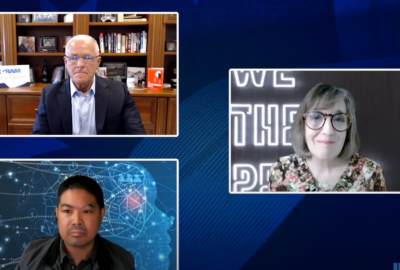Insight by Ingram Micro
3 trends drive how agencies use display technology now (all with security in mind)
As federal employees return to government offices, agencies are revamping their collaboration spaces along with other ways they use displays. To get the details, we...
This is the 10th article in our series, The Power of Technology.
As leaders and IT teams in all organizations rethink how employees in and out of the office interact with one another, a critical element are the displays in use — and not the ones in use on desktops.
“Wi-Fi has become standard across all types of technologies, including displays,” said Mike Bahniuk, senior director of government for public sector, federal and state & local at Samsung Electronics. “What’s happening in government agencies and in the security offices at these agencies is they actively want to control that Wi-Fi access. They don’t want that display sitting in a conference room or elsewhere to just set as an open-access, Wi-Fi connection.”
To understand the critical trends taking place with display use across government, Federal News Network talked with Bahniuk and Tony Celeste, executive director and general manager for Ingram Micro Public Sector for our The Power of Technology series.
They identified three trends taking place now across government: layering in security with ease of use, delivering feature-rich environments and improving citizen services.
Making sure that display use and content can be controlled and managed is key.
“We take that very seriously at Samsung. We have SKUs that are set up specifically for federal uses,” Bahniuk said. “It’s really about adapting products that are designed specifically for the government.”
Display trend No. 1: Layering in security with ease of use
The trick really is to find the sweet spot between ease of use and security when it comes to display use, Celeste said.
Bahniuk agreed. With Wi-Fi access, that means when someone comes into a conference room or collaboration space, they’re not searching for a dongle. But agencies also want to ensure people have the proper credentials too, he said.
“We’ve gone through security analyses and approval ratings at some of the biggest agencies — Army, Air Force, Navy. The Navy was actually the first that started this, as well as some of the big three-letter intel agencies up at Fort Meade,” Bahniuk said.
To make managing the security aspects easier, Samsung hasn’t just left some features on with the ability to disable them. “Instead, we’ve taken our biggest commercial flagship model and taken some services out,” he said. “It’s not a menu setting to disable them. Because if you can disable them, somebody else can turn them back on.”
As to managing content and devices, many federal organizations need centralized capabilities. For displays in large conference rooms or big command centers, Samsung MagicInfo provides content and device management so that agencies can control displays across their organizations centrally.
“We’re working on a system with the Centers for Disease Control and Prevetion where they’re using MagicInfo to help drive content back to their displays that are out in their quarantine stations around the country,” Bahniuk said. “It’s all from one supplier, all integrated together. We also recently released a new MagicInfo version in the cloud so that it’s easier to adapt and secure content remotely.”
Display trend No. 2: Delivering feature-rich environments
It’s important to understand some fundamental feature capabilities that drive the purchase of displays now, Celeste said.
“Agencies are buying displays largely for visualization,” he said. “They’re doing a lot more video streaming, high-definition, increased resolution. The frame rates matter today. The quality of what they’re seeing matters. The refraction — all these things are also important.”
The use of displays is changing too as agencies plan for the future of work and the return of employees more regularly to federal offices, both Bahniuk and Celeste said.
“These conference rooms and spaces have been sitting stagnant for a couple years. Agencies are tearing down the traditional whiteboards, and they’re putting in big displays. They’re putting in interactive displays to communicate closely with their teams,” Bahniuk said. “It’s really important when engaging with those remote users that we make each remote user feel more of a part of the meeting.”
The same is true for the use of displays in mission control, network operations centers and situational awareness rooms, Celeste added. Plus, there’s a need for resilience. “If one of them goes down, then it’s a massive undertaking and can be very disruptive to the environment,” he said.
From a security perspective, managing access in these environments as well as the content is also a factor — along with supply chain risk management. That leads to numerous validation and compliance concerns.
“Where’s the product made? Is it made in a trade-friendly country? Are we following secure supply chain practices to guarantee where the products are coming from?” Bahniuk said.
Statements of volatility — what happens with the content on those systems when users change — matter as well, Celeste said.
“Agencies need to understand what residual information may reside there permanently or how to clear those buffers so that there is no residual information because that information could be sensitive or could be classified,” he said.
Samsung focuses on all of these aspects holistically for its federal products, Bahniuk said. “We really get into details for these security pieces, and we’ve really thought these through as a whole.”
All Samsung displays include the company’s Knox security platform, he added. “It’s the same platform that’s in our phones and accepted at some of the most secure agencies.” Bahniuk described Knox as an added layer of protection on the back end to help thwart intrusions.
He also pointed to a fairly new security labeling program launched by the White House, the U.S. Cyber Trust Mark. Akin to the Environmental Protection Agency’s Energy Star program, technology makers — including Samsung — have agreed to label products that meet established cybersecurity criteria. While the program focuses on helping consumers identify trustworthy products, it could also be helpful to enterprise organization, the White Housed noted.
Display trend No. 3: Improving the experience and user services
There’s also the aspect of customer experience, which affects both the public and federal employees.
Airports offer a great example, Celeste said. “You have the Transportation Security Administration using display technology and cameras to map your facial image very quickly back to your ID,” he said. “They’re not relying on the TSA agents anymore to look at the picture and validate that you’re the person on the ID. They’re allowing a form of artificial intelligence to potentially do that.”
Meanwhile, Bahniuk shared details about a project at the U.S. Postal Service that helps employees track the movement of mail. “All the regional postal offices are using displays to monitor what’s happening on the postal lines in the mail, mail sorting, all this stuff on the back side of the regional centers,” he said.
For USPS, that used to be a manual process, Bahniuk said, adding that now tracking details appear in real time on displays, and USPS has access to data to help better manage resources, identify trends and address mail processing challenges.
“These examples show how this technology is advancing incredibly rapidly and how the technology helps agencies deliver their missions better,” Celeste said.
Engineered to be enjoyed right out of the box
The conference room of the future is starting to happen now in the federal government, Samsung’s Mike Bahniuk said.
As agencies continue to reinvent these spaces, Samsung has tried to make it easier to stand up new display technologies.
“We just introduced what we call the All-In-One LED. It’s a very simple piece. It comes in two sizes and two resolutions. Everything comes physically in one box, which makes installation take only a few hours,” Bahniuk said.
“So the pricing has come down, the resolution and clarity has gone up, and the install time has really come down to upgrade those conference rooms and lobbies and to replace those projectors in big auditoriums with more digital displays. That’s where we’re seeing a lot of momentum is right now.”
To read more articles in The Power of Technology series, click here.
Copyright © 2025 Federal News Network. All rights reserved. This website is not intended for users located within the European Economic Area.






